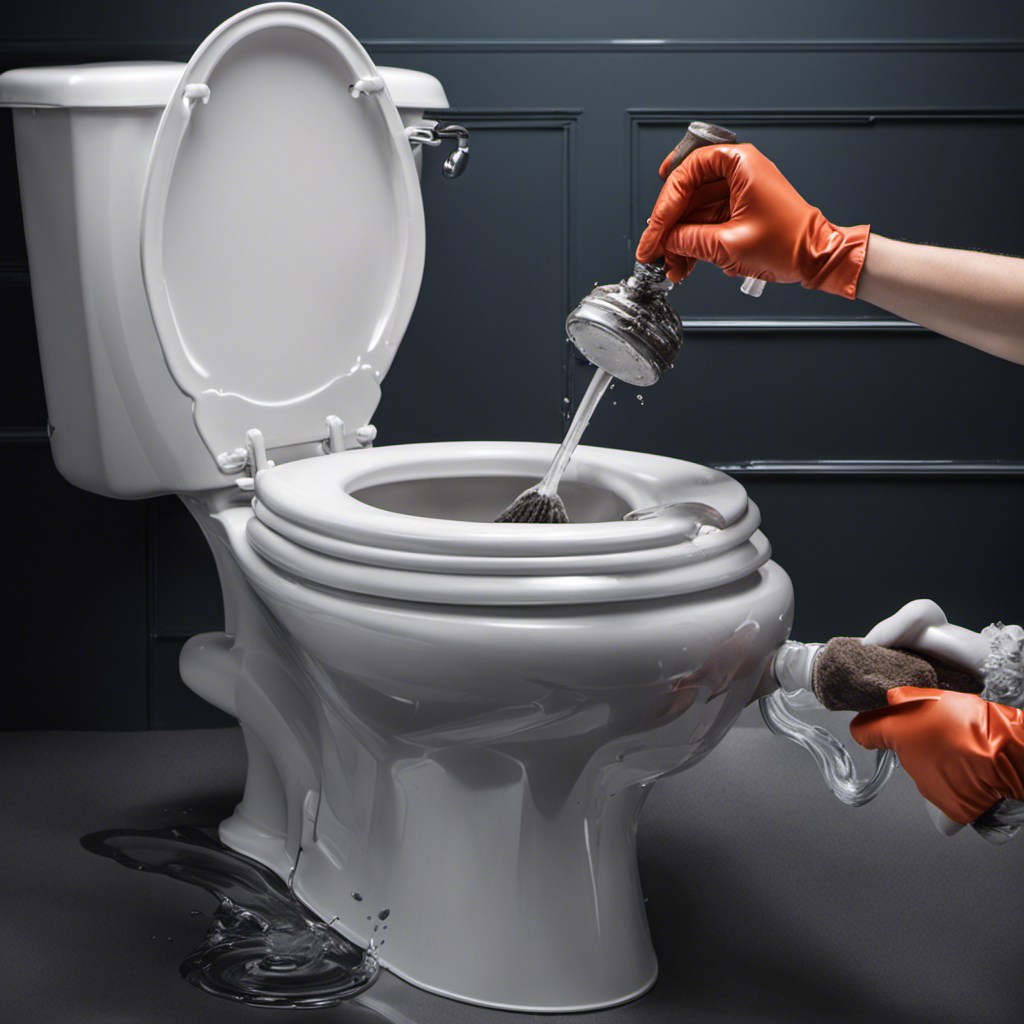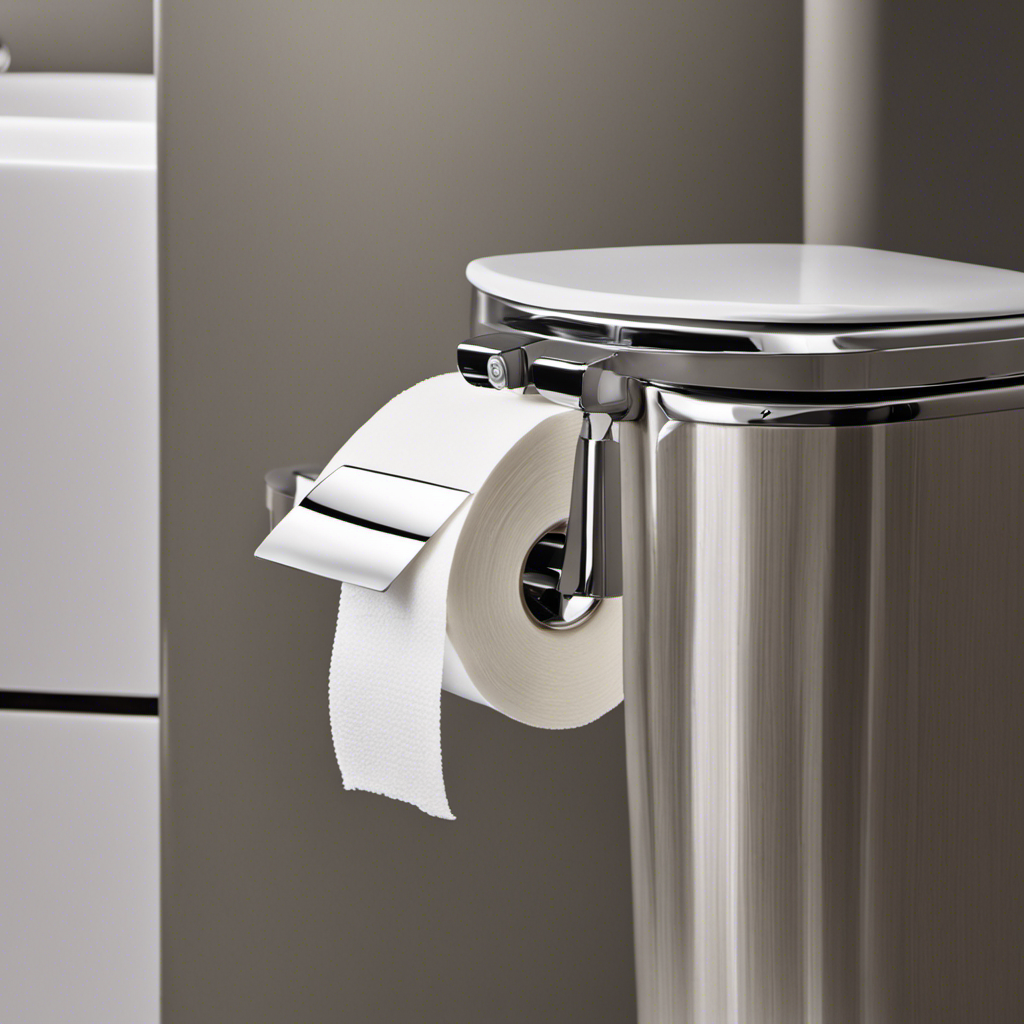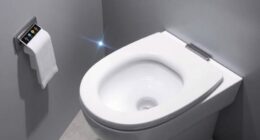Hey there! Ever been in a messy situation with a clogged toilet? Trust me, I’ve been there too. But don’t worry, I’ve got some tried and tested methods that will help you naturally unclog your toilet in no time.
No need for harsh chemicals or expensive plumbers. In this article, I’ll walk you through step-by-step instructions, provide you with a list of tools and materials you’ll need, and even share some preventive measures to avoid future clogs.
So let’s get started and put an end to those pesky toilet clogs!
Key Takeaways
- Excessive toilet paper usage and flushing items besides toilet paper and human waste are common causes of toilet clogs.
- A plunger, bucket, rubber gloves, and a wire hanger are tools and materials that can be used to unclog a toilet naturally.
- Wire hangers can be used to break up or pull out the clog, while a mixture of baking soda and vinegar can be left to sit before flushing to clear the clog.
- To prevent future toilet clogs, only flush toilet paper and waste, regularly clean the toilet bowl and flush valve seal, check the water level and replace worn-out parts, and use vinegar or lemon juice for cleaning to prevent mineral buildup.
Common Causes of Toilet Clogs
One of the most common causes of toilet clogs is excessive toilet paper usage. It’s important to be mindful of how much toilet paper we use to prevent clogs from occurring. When we use too much toilet paper, it can easily become stuck in the pipes and cause blockages.
To prevent toilet clogs, it’s recommended to use a reasonable amount of toilet paper and avoid flushing any other items besides toilet paper and human waste. Signs of a clogged toilet include water rising in the bowl instead of draining, slow flushing or complete inability to flush, and gurgling sounds coming from the pipes.
Tools and Materials You’ll Need
To successfully tackle this task, you’ll need a plunger, a bucket, and a pair of rubber gloves.
But what if you don’t have a plunger or prefer to try alternatives? Don’t worry, there are still DIY toilet unclogging solutions you can try.
One option is using a wire hanger. Straighten it out, bend one end into a small hook, and use it to break up the clog or pull it out.
Another option is using hot water and dish soap. Pour a bucket of hot water into the toilet bowl, followed by a generous amount of dish soap. Let it sit for a few minutes, and then try flushing.
If these methods don’t work, you may need to call a professional plumber.
Step-by-Step Guide to Unclogging a Toilet Naturally
If you’re looking for a DIY solution, you can try using a wire hanger to break up the clog or pull it out.
However, if you prefer a more natural approach, there are homemade toilet unclogging solutions that can be just as effective. One popular method is using a mixture of baking soda and vinegar.
Start by pouring half a cup of baking soda into the toilet bowl. Follow this up with a cup of vinegar, and let the mixture sit for about 30 minutes. Then, flush the toilet to see if the clog has cleared.
The benefits of using natural methods for unclogging a toilet are that they are affordable, environmentally-friendly, and safe for your plumbing system.
Preventing Future Toilet Clogs
To prevent future clogs, make sure to only flush toilet paper and waste down the toilet. Avoid flushing anything else, such as paper towels, feminine hygiene products, or baby wipes, as these can easily cause blockages. Regular maintenance is key to keeping your toilet healthy and clog-free. Here are some eco-friendly solutions and maintenance tips for a healthy toilet:
| Maintenance Tips | Eco-Friendly Solutions | Common Causes of Clogs |
|---|---|---|
| Regularly clean the toilet bowl and flush valve seal. | Use natural, biodegradable toilet cleaners. | Too much toilet paper. |
| Check the water level in the tank and adjust if necessary. | Install a low-flow toilet to conserve water. | Flushing non-flushable items. |
| Inspect and replace worn-out parts, such as flapper valves. | Use a plunger or a toilet auger instead of harmful chemical drain cleaners. | Tree roots invading the sewer line. |
| Prevent mineral buildup by using vinegar or lemon juice for cleaning. | Use a composting toilet for a sustainable option. | Inadequate water pressure. |
| Install a mesh screen over the drain to catch hair and debris. | Recycle toilet paper made from recycled materials. | Aging plumbing system. |
Alternative Methods for Unclogging a Toilet
For a quick fix when facing a clogged toilet, try using a plunger or a toilet auger. These tools are effective in dislodging blockages and getting your toilet working properly again.
However, if you’re looking for alternative methods that are chemical-free and eco-friendly, here are a few options to consider:
-
Baking Soda and Vinegar: Start by pouring a cup of baking soda into the toilet bowl, followed by a cup of vinegar. Let the mixture sit for a few minutes, and then flush the toilet. The chemical reaction between the baking soda and vinegar can help break down the clog.
-
Hot Water and Dish Soap: Boil a pot of water and add a few squirts of dish soap. Carefully pour the hot water into the toilet bowl and let it sit for a few minutes. The heat and soap can help to dissolve the clog.
-
Wire Coat Hanger: Straighten out a wire coat hanger and create a small hook or bend at one end. Insert the hooked end into the toilet drain and gently maneuver it to dislodge the clog. Be careful not to scratch the porcelain.
Frequently Asked Questions
Can I Use Chemical Drain Cleaners to Unclog a Toilet?
Using chemical drain cleaners to unclog a toilet has both pros and cons. It can be effective in breaking down clogs, but it may damage pipes and harm the environment. Alternatives include using a plunger or a natural mixture of baking soda and vinegar.
What Should I Do if the Toilet Is Still Clogged After Following the Step-By-Step Guide?
If the toilet is still clogged after following the guide, I would try alternative methods like using a plunger or a toilet auger. If all else fails, I’d consider calling a plumber for assistance.
Are There Any Specific Types of Toilet Paper That Are More Likely to Cause Clogs?
There are certain types of toilet paper that are more likely to cause clogs. To avoid this, choose toilet paper that is labeled as septic-safe or biodegradable, and avoid using excessive amounts.
Can I Use a Plunger Instead of the Recommended Tools and Materials?
Yes, you can use a plunger as an alternative to the recommended tools and materials for unclogging a toilet. It’s a practical option, but keep in mind the pros and cons of using a plunger for effective unclogging.
Are There Any Natural Remedies to Prevent Future Toilet Clogs?
To prevent future toilet clogs, there are natural remedies you can try. One option is to regularly pour 1 cup of baking soda followed by 2 cups of vinegar down the toilet. Let it sit for a few hours, then flush.
Conclusion
In conclusion, unclogging a toilet naturally doesn’t have to be a daunting task. By following these simple steps and using common household items, you can save yourself from the hassle and expense of calling a plumber.
Whether it’s using a plunger, a mixture of hot water and dish soap, or a combination of baking soda and vinegar, there are plenty of effective methods to choose from.
So next time your toilet gets clogged, don’t panic! Just remember these tips and you’ll be back to a smoothly running bathroom in no time.










